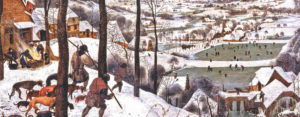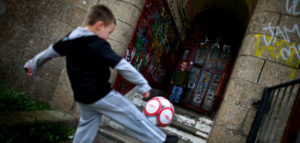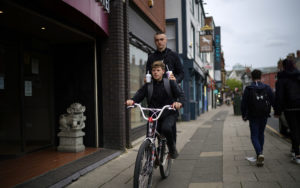In the Celtic fringes of Europe, the idea of “thin places” persists — locations where the boundary between this reality and others is claimed to be at its most fragile, even permeable. Originally, these were seen as portals to the Otherworld of Ancient Gaelic belief and the realm of faerie folk, or Sidhe, and other mythological entities. Recognising their appeal and resilience, the church absorbed these stories and superstitions into the faith; the mountains, lakes and islands that had served as pagan thin places gradually became sites of pilgrimage, areas where the distance between this world and the Christian afterlife might be at its most tenuous. Just as there are thin places, thin times might also be posited — the period, for example, at the end of October and beginning of November when Halloween, All Saints’ Day and All Souls’ Day fall in succession and, it is claimed, spirits walk the earth.
Even in our supposedly rationalist secular era, we find one of these thin places or times in the unlikely guise of Christmas and its rich repository of ghost stories. The supernatural was not banished by the developments of modernity but rather it evolved and adapted, moving from enchanted woods to gothic houses to the streets and rooms of Victorian cities. Just as in earlier times, they found their place where it is dark, in the dead of winter, when the nights close in and fireside stories cause the mind to play tricks and shadows to seemingly change their forms.
Among the many writers who have tried their hand at yuletide ghost stories, none loom larger than Charles Dickens who, with A Christmas Carol (subtitled Being a Ghost Story of Christmas), fundamentally influenced the way we perceive and celebrate the festivity. To fully understand how and why Christmas became a thin place and remains so, we have to delve into a scourge at the very heart of Dickens’s story and our society still — loneliness.
Christmas is one of those times when, as a much earlier writer, Dante, put it: “There is no greater sorrow than to recall in misery the time when we were happy.” And what time is happier, or more melancholic when irretrievable, than a childhood Christmas? Victorian writers knew that when we are alone at Christmas, a time that seems intrinsically meant for loved ones congregating (the perpetual renewal of the Nativity scene), our ghosts, borne by memory, absence and regret, would instead arrive.
Dickens knew the power of myth, and how the beautiful lie might reveal the hidden truth. Determined to speak out about the horrors of child labour and poverty he had directly experienced and witnessed, Dickens first toyed with writing a strident but fairly unwieldly political jeremiad until he realised, correctly, that there was a much more seductive approach available, through the Trojan Horse of storytelling. It was all too easy to turn away from a lecture or respond with platitudes and fallacies, but a heart-stirring tale had the ability to get under one’s skin. His characters and settings were constructed not just from satirical observations of the powerful but from encounters Dickens had had with the powerless, during his lengthy night walks around London. He was also deeply inspired, and haunted, by macabre tales that his cockney nursemaid Mary Weller used to delight in telling him as a child — full of Faustian pacts, treacherous innkeepers, poisons “distilled from toads’ eyes and spiders’ knees”, the Black Cat and Captain Murderer. To add to the unease, Weller would claim the horrors were true and she had witnessed them herself or had heard them from relatives who were eyewitnesses. As Dickens later recounted, in The Uncommercial Traveller, she “took a fiendish enjoyment of my terrors, and used to begin, I remember — as a sort of introductory overture — by clawing the air with both hands, and uttering a long low hollow groan”.
A Christmas Carol has this oral tradition feel, albeit delivered in a short, and affordable, novella form. It also rebalances Dickens’s heavy lean towards sentimentality (the pitiable figure of Tiny Tim, for instance) with the resolutely unsentimental tactic of terrifying child readers. This was necessary for reasons of veracity — existence was unsentimental in those days — but also as a myth-making technique. There are few lessons that stay with us longer and deeper than those which strike mortal fear in us and then propose a way out.
At the heart of the story and its extraordinary legacy is loneliness. Rereading A Christmas Carol, its power initially comes from its status as a social tract and a fable. What is crucial, however, is its existential quality. It shows that the system then in place, and perhaps still, not only oppresses and squanders but it also alienates. Dickens takes the traditional Christmas theme of visitation (the announcing angel, the wandering star leading to the Christ child, the shepherds, the Magi) and makes it sinister. Salvation can come only through the painful process of facing the truth (“Without their visits,” said the Ghost, “you cannot hope to shun the path I tread”). It can only emerge from Scrooge seeing that he has betrayed and marginalised not only his fellow human beings but himself, acknowledging that he belongs to the Malthusian “surplus population” he castigates, that he is alone and bereft (“Will you not speak to me?” he begs the final phantom), and the only precious hope he has left is to be found through gratitude and selfless communion with others.
There are many reasons why A Christmas Carol still resonates so much in the 21st century, not least Dickens’s vivid scene-setting and skill at characterisation, but one overlooked factor is that, although times are very different, we are still beholden to its curse. In 2017, the cross-party Jo Cox Commission stated that nine million people in the UK were stricken by loneliness, with all manner of health and societal issues emanating from this (depression, obesity, alcoholism, drug use and so on).
Loneliness can also have a horrifically brutal side to its tragedy. Before she was murdered by a radicalised recluse, a man who according to the police “never held down a job, never had a girlfriend, never any friends to speak of”, Jo Cox declared: “I will not live in a country where thousands of people are living lonely lives forgotten by the rest of us.” The reality, however, is that we do live in such a country.
Scrooge’s damnation (and redemption) is a personal one, but it is also societal. He cuts himself off partly because he cannot deal with the ethical complications and emotional demands of the world. He becomes impervious to weather and humane interaction. His is the reason of the counting house. He knows the cost of everything and the value of nothing. “Bah humbug” becomes a device to shut down any intrusive altruistic or life-affirming thoughts. His self-diminishment reaches a strange kind of perfection. He is the creation of an entire society that has been moving, in dedicated even pious fashion, in entirely the wrong direction and at great cost. Yet there must be great profit to be made in maintaining such a miserable situation. One of the most chilling scenes in A Christmas Carol, one I had entirely forgotten until rereading, is when Scrooge looks out over London and finds: “The air was filled with phantoms, wandering hither and thither in restless haste, and moaning as they went. Every one of them wore chains like Marley’s Ghost; some few (they might be guilty governments) were linked together; none were free.”
The story feels evergreen because, like Christmas, it renews. And it calls on us to look again at our times, as Dickens did his, and see that Scrooge, though wretched, is a product of his age. What are the ghosts of our current Christmas? Well, chief among them remains loneliness, adding to the unseen miseries of food banks, child poverty, domestic abuse, heating, and housing crises. A consumerist and media-driven cult of youth encourages us to, hubristically, treat the neglected old as redundant. Simultaneously, the young are betrayed with the atomisation that comes with a life of screens, increasingly devoid of extended family, subject to risk-averse short-termism and apocalyptic anxieties in the long-term, all compounded by the as-yet-unquantified impact of lockdown upon child development.
Adults hardly fare much better. A 2019 YouGov survey showed that 18% men did not have a close friend, with 32% having no one they regarded as a best friend. Women fared better, but still enough for concern, with 12% and 24% respectively. Despite, or because, of the proponderence of dating apps, there are a plethora of studies showing each successive generation of adults is having less sex than the last (in hetereosexual circles at least). Urbanisation has also played a significant role in this with the “Lonely in a crowd…” study, published last year in Nature, finding that “being in overcrowded environments increased loneliness by up to 38%”. While it’s important to acknowledge the benefits of voluntary solitude and the underrated qualities of introversion, the study sets out what might be a definitive summation of the problem: “Loneliness, defined as the ‘perceived sense of disconnection from others’, refers to the subjective emotional experience of not having one’s social need for relationships adequately met.” It is arguable that the needs contemporary society focuses on are not those we actually need.
Throughout his books, Dickens returned to the theme of loneliness and many of his passages feel prescient. In A Tale of Two Cities, he observes “a multitude of people, and yet a solitude!” In Great Expectations, he touches upon a scene that chimes with our current crisis of homelessness: “I looked at the stars, and considered how awful it would be for a man to turn his face up to them as he froze to death, and see no help or pity in all the glittering multitude.” So much has changed and yet so little.
We have more ways than ever to communicate, except the tangible ones that actually matter. We may have moved on from old-fashioned firesides and pan-generational environments, banquets and carol services, midnight masses and midnight toasts, for the sophistication of empty rooms filled with nothing but technological phantoms. Scrooge the miser does not seem a contemporary figure in our age of profligacy, but this would be a misreading, for it is the solipsism of his ego that leads Scrooge to where he’d languished and transcending that is what redeems him in the end and helps him find his place. Solipsism takes many different forms but there’s only one path out of it. This is the nature of the true thin place, a portal through which we leave our echo-chambers and egos and meet in one another’s worlds. We must reach and wander outside of ourselves, lest we diminish into shades of ourselves. As it is put in A Christmas Carol: “It is required of every man,” the ghost returned, “that the spirit within him should walk abroad among his fellow-men, and travel far and wide; and, if that spirit goes not forth in life, it is condemned to do so after death.”
The beauty and grace of Christmas comes because it is a temporary reprieve from hardship and the rebirth of hope in the depths of winter. It is an island, full of lights, cheer, charity and togetherness, in a sea of darkness. Or, at least, it could be. The more we forget this as an individual or a society, the more we risk finding ourselves out there in the dark, shut off from the world, like ghosts of what we could have been.
Disclaimer
Some of the posts we share are controversial and we do not necessarily agree with them in the whole extend. Sometimes we agree with the content or part of it but we do not agree with the narration or language. Nevertheless we find them somehow interesting, valuable and/or informative or we share them, because we strongly believe in freedom of speech, free press and journalism. We strongly encourage you to have a critical approach to all the content, do your own research and analysis to build your own opinion.
We would be glad to have your feedback.
Source: UnHerd Read the original article here: https://unherd.com/





